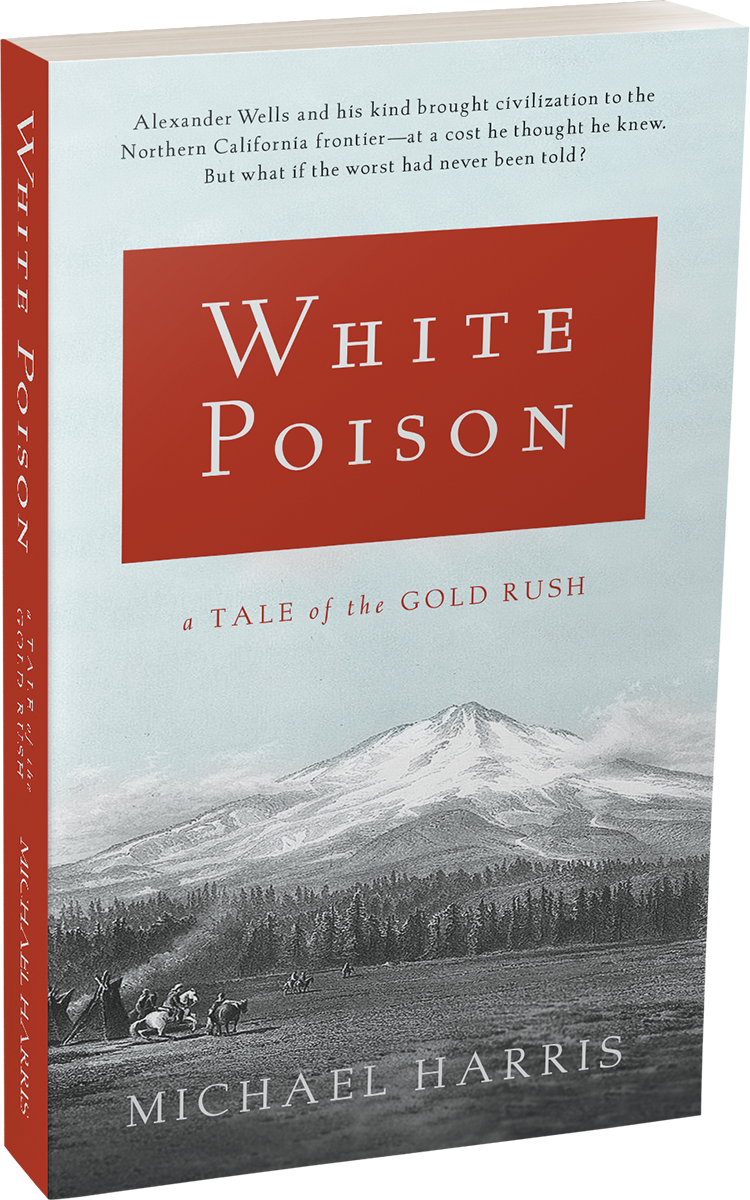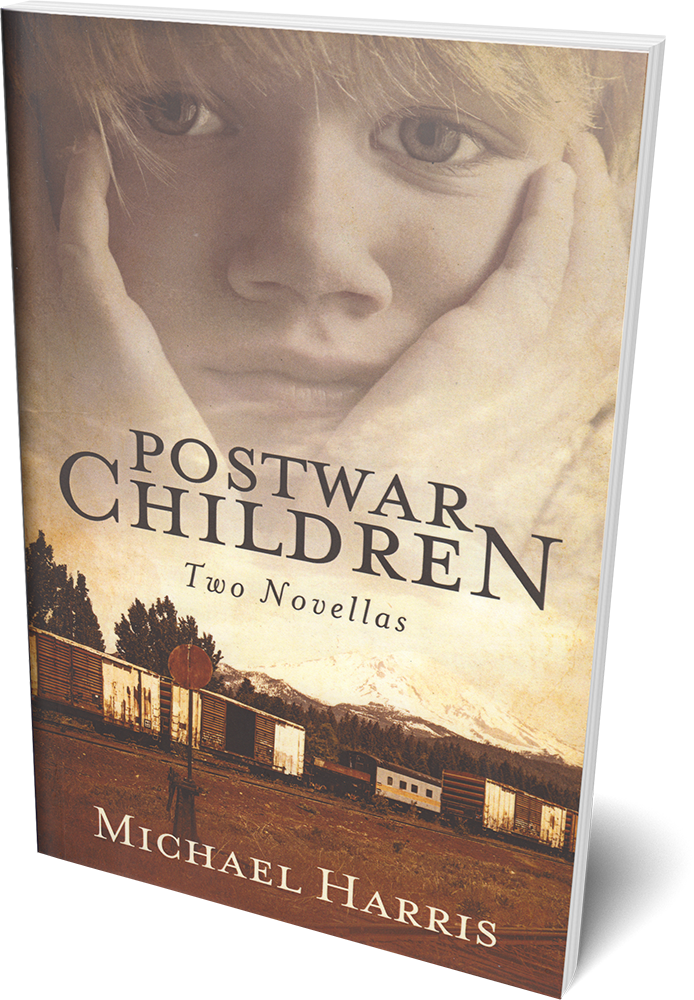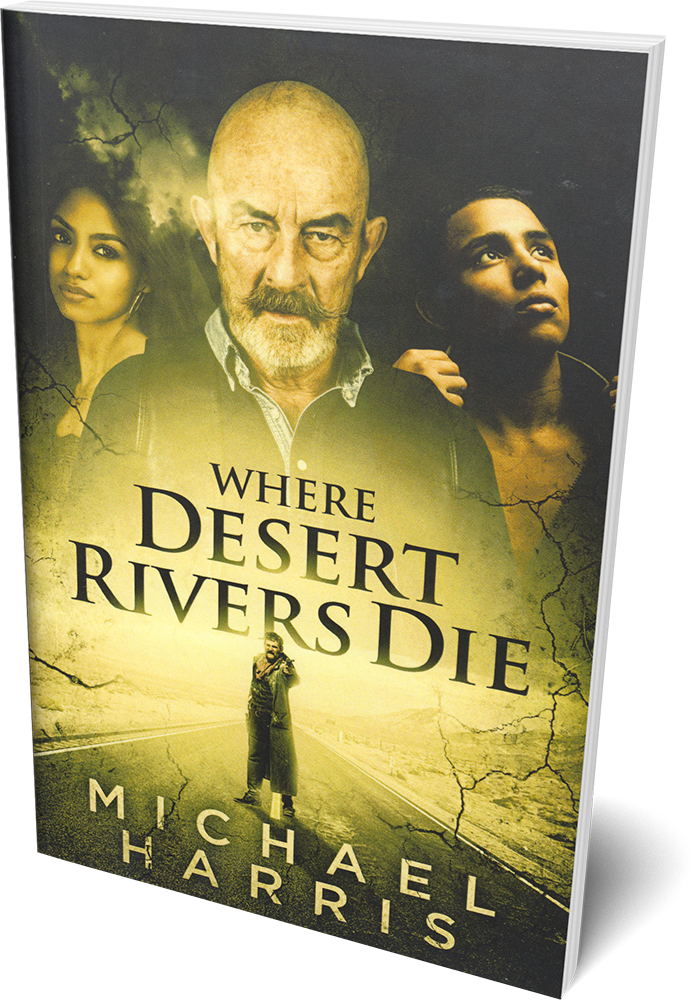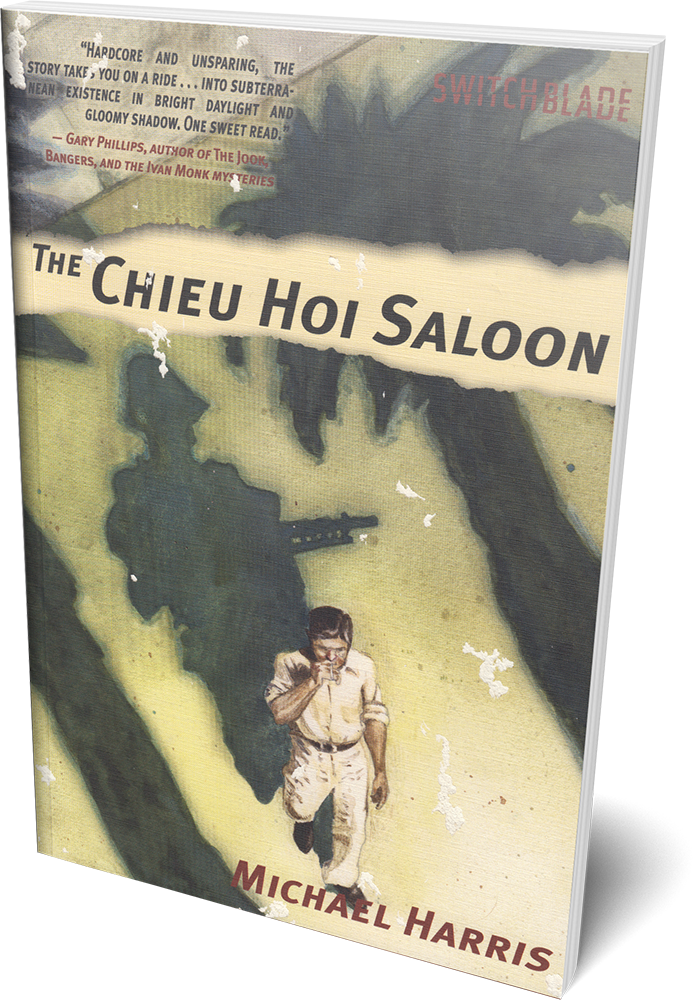White Poison
Were up to 3,000 Shasta Indians fed strychnine-laced beef and bread at a treaty-signing feast in far Northern California in 1851? And was this Gold Rush atrocity, with 10 times the death toll of Wounded Knee, somehow covered up and forgotten for a century and a half?
Michael Harris’ new novel, White Poison, tries to exhume the truth about this alleged massacre and other, better documented clashes in Siskiyou County and Southern Oregon between settlers and Natives — none of which he learned about in school, though he grew up in the area.
Harris is a former Los Angeles Times news editor and book reviewer, a graduate of the University of Iowa Writers’ Workshop and the author of four other works of fiction: The Chieu Hoi Saloon, Romantic History, Where Desert Rivers Die and Postwar Children.
White Poison, like Thomas Berger’s Little Big Man, is an Old West epic told in the leathery voice of a man, Alexander Wells, who has lived through it all as emigrant, ambush victim, orphan, Indian fighter, prospector, rancher and lawyer. He thinks he has seen, and sometimes done, all the good and evil that people can do, but a deathbed revelation by an old enemy, Shasta tribesman Tyee Bob, suggests he doesn’t know nearly enough. In 1911, gravely ill and running out of time, Wells finally sets pen to paper.
If Bob’s story is true, Wells realizes, “everything we have struggled for three generations to build here…rests on a foundation even more treacherous than the fissured rock that lay under San Francisco before the great quake, when the skin of the Earth twitched like the hide of an old flea-ridden dog and our proudest towers fell in a twinkling.
“It rests on blood.
“More blood than I had ever imagined.”

Now Available!
Romantic History
Two spectacularly mismatched young people meet at a halfway house in a Seattle suburb in 1971. Paul Siebert is a reporter, a shy, depressive Vietnam veteran, already chastened by the blows life has dealt him. Maggie Ryan is a wild child, a rape victim, a musician, an armed robber, determined to live life to the fullest. They have no business falling in love, no plausible future together. But whatever initially connects them, though it often flickers, refuses to die. Over the next 35 years, as each separately tries to make a settled life, their attraction never stops being an inspiration, and a danger. In the tradition of John Fowles’ “The French Lieutenant’s Woman,” Michael Harris’ “Romantic History” balances the claims of individual desire and family values, recklessness and prudence, idealism and delusion, the safe and the forbidden. Ranging from Southeast Asian war zones to a hippie encampment on Crete, from Spokane to Los Angeles, from newsrooms to jails, from the foot of Mount Shasta to the down-and-out streets of Boston, full of vivid and memorable minor characters, this novel follows the evolution of two souls who demand more than the world may be willing to give.

Postwar Children
In the early 1950s, the Southern Pacific Railroad no longer runs the state of California, as Frank Norris described it in “The Octopus.” It’s just another company. But in the little town of Dunsmuir, it still has enough power to force an injured brakeman, Frank Hiller, back to work to preserve its safety record, and Hiller, an angry man to begin with, passes the fear and pressure on to his wife and children. “Canyon,” the story of a single summer day when Hiller disappears, is told through the eyes of each of them in turn, including 10-year-old John, who fears his father but is even more frightened to see his father humiliated by a world that, just a few years after World War II, is saturated with images and memories of violence. That all around them is some of the most beautiful scenery in the state is only partial comfort.
In “Flucy,” an 11-year-old girl in broiling, unlovely San Bernardino catches polio in one of the last pre-vaccine epidemics. In a hospital full of dying children and children in iron lungs, overworked doctors and nurses fight to save her. One sympathetic nurse begins to intuit a truth the girl is too shy and downtrodden to tell – that for her, the hospital isn’t hellish at all; that compared with the dysfunctional family of Dust Bowl migrants she comes from, including a brother who is maturing into a full-blown psychopath, it’s almost like Heaven. Jessamyn Colton – or Flucy, as she is known dismissively at home – would just as soon stay in the hospital, but once she recovers – and she is recovering – that’s not an option.

Where Desert Rivers Die
Warren Holt has escaped his trailer-trash background through hard work and playing by the rules. But when he is unjustly fired by a Southern California newspaper, punches out a supervisor in a fit of rage and inadvertently kills the man, Holt’s middle-class dreams are destroyed. He heads for Denver, hoping to evade the police long enough to kill his boss’ bosses. Can an ordinary person with no previous history of violence become a “weapon” in the service of personal revenge and social justice – and if he can, at what cost? In the car with Holt is his 15-year-old Latino stepson, Ray Duarte, a nice kid who has his own agenda, especially after he meets a beautiful Mexican girl – perhaps a victim of sex trafficking – in remote Green River, Utah.

The Chieu Hoi Saloon
Set against the backdrop of the riots sparked by the beating of African American motorist Rodney King, Vietnam vet and reporter Harry Hudson wanders the city to forget his troubled past. Trying to cope with the posttraumatic stress disorder that has plagued him since his military tour, the overweight, depressed, and sex-obsessed Hudson stumbles through the underbelly of South Central LA, where he meets Mama Thuy, a Vietnamese woman struggling to run a Navy bar in a tough Long Beach neighborhood, and Kelly Crenshaw, an African American prostitute whose husband is in prison. As both women give Hudson a new outlook on life and faith, he discovers the shared humanity of all members of society. Suspenseful and thrilling, this noir-style novel is also a detailed character study of victims of racial, social, and economical tensions.

White Poison
Were up to 3,000 Shasta Indians fed strychnine-laced beef and bread at a treaty-signing feast in far Northern California in 1851? And was this Gold Rush atrocity, with 10 times the death toll of Wounded Knee, somehow covered up and forgotten for a century and a half?
Michael Harris’ new novel, “White Poison,” due out in —— 2020 from Black Opal Books, tries to exhume the truth about this alleged massacre and other, better documented clashes in Siskiyou County and Southern Oregon between settlers and Natives — none of which he learned about in school, though he grew up in the area.
Harris is a former Los Angeles Times news editor and book reviewer, a graduate of the University of Iowa Writers’ Workshop and the author of four other works of fiction: “The Chieu Hoi Saloon,” “Romantic History,” “Where Desert Rivers Die” and “Postwar Children.”
“White Poison,“ like Thomas Berger’s “Little Big Man,” is an Old West epic told in the leathery voice of a man, Alexander Wells, who has lived through it all as emigrant, ambush victim, orphan, Indian fighter, prospector, rancher and lawyer. He thinks he has seen, and sometimes done, all the good and evil that people can do, but a deathbed revelation by an old enemy, Shasta tribesman Tyee Bob, suggests he doesn’t know nearly enough. In 1911, gravely ill and running out of time, Wells finally sets pen to paper.
If Bob’s story is true, Wells realizes, “everything we have struggled for three generations to build here … rests on a foundation even more treacherous than the fissured rock that lay under San Francisco before the great quake, when the skin of the Earth twitched like the hide of an old flea-ridden dog and our proudest towers fell in a twinkling.
“It rests on blood.
“More blood than I had ever imagined.”

Romantic History
Two spectacularly mismatched young people meet at a halfway house in a Seattle suburb in 1971. Paul Siebert is a reporter, a shy, depressive Vietnam veteran, already chastened by the blows life has dealt him. Maggie Ryan is a wild child, a rape victim, a musician, an armed robber, determined to live life to the fullest. They have no business falling in love, no plausible future together. But whatever initially connects them, though it often flickers, refuses to die. Over the next 35 years, as each separately tries to make a settled life, their attraction never stops being an inspiration, and a danger. In the tradition of John Fowles’ “The French Lieutenant’s Woman,” Michael Harris’ “Romantic History” balances the claims of individual desire and family values, recklessness and prudence, idealism and delusion, the safe and the forbidden. Ranging from Southeast Asian war zones to a hippie encampment on Crete, from Spokane to Los Angeles, from newsrooms to jails, from the foot of Mount Shasta to the down-and-out streets of Boston, full of vivid and memorable minor characters, this novel follows the evolution of two souls who demand more than the world may be willing to give.

Postwar Children
In the early 1950s, the Southern Pacific Railroad no longer runs the state of California, as Frank Norris described it in “The Octopus.” It’s just another company. But in the little town of Dunsmuir, it still has enough power to force an injured brakeman, Frank Hiller, back to work to preserve its safety record, and Hiller, an angry man to begin with, passes the fear and pressure on to his wife and children. “Canyon,” the story of a single summer day when Hiller disappears, is told through the eyes of each of them in turn, including 10-year-old John, who fears his father but is even more frightened to see his father humiliated by a world that, just a few years after World War II, is saturated with images and memories of violence. That all around them is some of the most beautiful scenery in the state is only partial comfort.
In “Flucy,” an 11-year-old girl in broiling, unlovely San Bernardino catches polio in one of the last pre-vaccine epidemics. In a hospital full of dying children and children in iron lungs, overworked doctors and nurses fight to save her. One sympathetic nurse begins to intuit a truth the girl is too shy and downtrodden to tell – that for her, the hospital isn’t hellish at all; that compared with the dysfunctional family of Dust Bowl migrants she comes from, including a brother who is maturing into a full-blown psychopath, it’s almost like Heaven. Jessamyn Colton – or Flucy, as she is known dismissively at home – would just as soon stay in the hospital, but once she recovers – and she is recovering – that’s not an option.

Where Desert Rivers Die
Warren Holt has escaped his trailer-trash background through hard work and playing by the rules. But when he is unjustly fired by a Southern California newspaper, punches out a supervisor in a fit of rage and inadvertently kills the man, Holt’s middle-class dreams are destroyed. He heads for Denver, hoping to evade the police long enough to kill his boss’ bosses. Can an ordinary person with no previous history of violence become a “weapon” in the service of personal revenge and social justice – and if he can, at what cost? In the car with Holt is his 15-year-old Latino stepson, Ray Duarte, a nice kid who has his own agenda, especially after he meets a beautiful Mexican girl – perhaps a victim of sex trafficking – in remote Green River, Utah.

The Chieu Hoi Saloon
Set against the backdrop of the riots sparked by the beating of African American motorist Rodney King, Vietnam vet and reporter Harry Hudson wanders the city to forget his troubled past. Trying to cope with the posttraumatic stress disorder that has plagued him since his military tour, the overweight, depressed, and sex-obsessed Hudson stumbles through the underbelly of South Central LA, where he meets Mama Thuy, a Vietnamese woman struggling to run a Navy bar in a tough Long Beach neighborhood, and Kelly Crenshaw, an African American prostitute whose husband is in prison. As both women give Hudson a new outlook on life and faith, he discovers the shared humanity of all members of society. Suspenseful and thrilling, this noir-style novel is also a detailed character study of victims of racial, social, and economical tensions.

